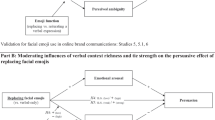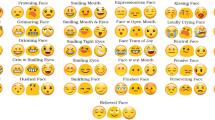Abstract
Facial expression emojis are commonly used in digital communications and marketing campaigns. However, it is less known how the design of emojis may affect consumer responses. To address this gap, this research examines the impact of emojis’ facial asymmetry levels on consumer judgments. Findings across four studies demonstrate that compared with their symmetric counterparts, asymmetric facial expression emojis are more likely to receive favorable consumer evaluations. This effect is driven by perceptions of human expression resemblance and emotional expression strength and tends to be more prominent among consumers with a higher level of emotional sensitivity. Moreover, marketing messages including an asymmetric (vs. a symmetric) emoji are more likely to generate positive consumer responses.



Similar content being viewed by others
References
Aggarwal, P., & McGill, A. L. (2007). Is that car smiling at me? Schema congruity as a basis for evaluating anthropomorphized products. Journal of Consumer Research, 34(4), 468–479.
And, B. B., & Ulrich, G. (1993). Asymmetries of expressive facial movements during experimentally induced positive vs. negative mood states: a video-analytical study. Cognition and Emotion, 7(5), 393–405.
Baribeau, J., Guerette, R., & Braun, C. (1987). Hemifacial production of posed emotional expression in normal men and women. In meeting of The International Neuropsychological Society, Washington, DC.
Barlow, H. B., & Reeves, B. C. (1979). The versatility and absolute efficiency of detecting mirror symmetry in random dot displays. Vision Research, 19(7), 783–793.
Bomey, N. (2016). Emojis to grace Pepsi products in summer campaign. Retrieved from https://www.usatoday.com/story/money/2016/02/19/pepsi-emoji-advertising-marketing-campaign/80602336/.
Borod, J. C., Haywood, C. S., & Koff, E. (1997). Neuropsychological aspects of facial asymmetry during emotional expression: a review of the normal adult literature. Neuropsychology Review, 7(1), 41–60.
Borod, J. C., St Clair, J., Koff, E., & Alpert, M. (1990). Perceiver and poser asymmetries in processing facial emotion. Brain and Cognition, 13(2), 167–177.
Carmody, D. P., Nodine, C. F., & Locher, P. J. (1977). Global detection of symmetry. Perceptual and Motor Skills, 45(3_suppl), 1267–1273.
Chitturi, R., Raghunathan, R., & Mahajan, V. (2008). Delight by design: the role of hedonic versus utilitarian benefits. Journal of Marketing, 72(May), 48–63.
Churches, O., Nicholls, M., Thiessen, M., Kohler, M., & Keage, H. (2014). Emoticons in mind: An event-related potential study. Social Neuroscience, 9(2), 196–202.
Cupchik, G. C., & Poulos, C. X. (1984). Judgments of emotional intensity in self and others: The effects of stimulus context, sex, and expressivity. Journal of Personality and Social Psychology, 46(2), 431–439.
Das, G., Wiener, H. J., & Kareklas, I. (2019). To emoji or not to emoji? Examining the influence of emoji on consumer reactions to advertising. Journal of Business Research, 96, 147–156.
Fink, B., Neave, N., Manning, J. T., & Grammer, K. (2005). Facial symmetry and the ‘big-five’ personality factors. Personality and Individual Differences, 39(3), 523–529.
Forgas, J. P., & East, R. (2008). How real is that smile? Mood effects on accepting or rejecting the veracity of emotional facial expressions. Journal of Nonverbal Behavior, 32(3), 157–170.
Grammer, K., & Thornhill, R. (1994). Human (Homo sapiens) facial attractiveness and sexual selection: the role of symmetry and averageness. Journal of Comparative Psychology, 108(3), 233–242.
Hayes, A. F. (2013). Introduction to mediation, moderation, and conditional process analysis: A regression-based approach. New York, NY: Guilford Press.
Hayes, A. F., & Matthes, J. (2009). Computational procedures for probing interactions in OLS and logistic regression: SPSS and SAS implementations. Behavior Research Methods, 41(3), 924–936.
Hof, R. D. (2016). Picture this: Marketers let Emojis do the talking, New York Times. Retrieved from https://www.nytimes.com/2016/03/07/business/media/picture-this-marketers-let-emojis-do-the-talking.html.
Johnston, V. S. (1999). Why we feel: the science of human emotions. Reading, MA: Perseus Books.
Kring, A. M., Smith, D. A., & Neale, J. M. (1994). Individual differences in dispositional expressiveness: development and validation of the emotional expressivity scale. Journal of Personality and Social Psychology, 66(5), 934–949.
Landwehr, J. R., McGill, A. L., & Herrmann, A. (2011). It's got the look: The effect of friendly and aggressive “facial” expressions on product liking and sales. Journal of Marketing, 75(3), 132–146.
Li, X., Chan, K. W., & Kim, S. (2018). Service with emoticons: how customers interpret employee use of emoticons in online service encounters. Journal of Consumer Research, 45(5), 973–987.
Locher, P., & Nodine, C. (1989). The perceptual value of symmetry. Computers & Mathematics with Applications, 17(4–6), 475–484.
Luangrath, A. W., Peck, J., & Barger, V. A. (2017). Textual paralanguage and its implications for marketing communications. Journal of Consumer Psychology, 27(1), 98–107.
Meola, A. (2016). Mobile marketers are embracing emojis to reach consumers. In Business Insider Retrieved from https://www.businessinsider.com/emoji-use-in-mobile-marketing-rises-775-2016-3.
Monserrat, L. (1985). Facial asymmetry in the spontaneous expression of emotion: an index of the role of functional brain asymmetry in the regulation of emotional expression. Dissertation Abstracts International, 45(8-B), 2696.
Nock, M. K., Wedig, M. M., Holmberg, E. B., & Hooley, J. M. (2008). The emotion reactivity scale: development, evaluation, and relation to self-injurious thoughts and behaviors. Behavior Therapy, 39(2), 107–116.
Novak, P. K., Smailović, J., Sluban, B., & Mozetič, I. (2015). Sentiment of emojis. PLoS One, 10(12), 0144296.
Pegna, A. J., Khateb, A., Michel, C. M., & Landis, T. (2004). Visual recognition of faces, objects, and words using degraded stimuli: where and when it occurs. Human Brain Mapping, 22(4), 300–311.
Perrett, D. I., Burt, D. M., Penton-Voak, I. S., Lee, K. J., Rowland, D. A., & Edwards, R. (1999). Symmetry and human facial attractiveness. Evolution and Human Behavior, 20(5), 295–307.
Perrett, D. I., Oram, M. W., Harries, M. H., Bevan, R., Hietanen, J. K., Benson, P. J., & Thomas, S. (1991). Viewer-centered and object-centered coding of heads in the macaque temporal cortex. Experimental Brain Research, 86(1), 159–173.
Rampone, G., Makin, A. D., Tatlidil, S., & Bertamini, M. (2019). Representation of symmetry in the extrastriate visual cortex from temporal integration of parts: An EEG/ERP study. NeuroImage, 193, 214–230.
Rhodes, G., Proffitt, F., Grady, J. M., & Sumich, A. (1998). Facial symmetry and the perception of beauty. Psychonomic Bulletin & Review, 5(4), 659–669.
Russell, C. A. (2002). Investigating the effectiveness of product placements in television shows: the role of modality and plot connection congruence on brand memory and attitude. Journal of Consumer Research, 29(3), 306–318.
Salgado-Montejo, A., Salgado, C. J., Alvarado, J., & Spence, C. (2017). Simple lines and shapes are associated with, and communicate, distinct emotions. Cognition and Emotion, 31(3), 511–525.
Scheib, J. E., Gangestad, S. W., & Thornhill, R. (1999). Facial attractiveness, symmetry and cues of good genes. Proceedings of the Royal Society of London B: Biological Sciences, 266(1431), 1913–1917.
Schmidt, K. L., Liu, Y., & Cohn, J. F. (2006). The role of structural facial asymmetry in asymmetry of peak facial expressions. Laterality, 11(6), 540–561.
Schultz, E. (2017). Toyota targets more than 80 twitter ads based on emoji use. Ad Age. Retrieved from https://adage.com/article/cmo-strategy/toyota-targets-80-twitter-ads-based-emoji/310321/?utm_campaign=SocialFlow&utm_source=Facebook&utm_medium=Social.
Thornhill, R., & Gangestad, S. W. (1999). Facial attractiveness. Trends in Cognitive Sciences, 3(12), 452–460.
Unicode. (2019). Emoji frequency. Retrieved from https://home.unicode.org/emoji/emoji-frequency/.
Velten Jr., E. (1968). A laboratory task for induction of mood states. Behaviour Research and Therapy, 6(4), 473–482.
Wagemans, J. (2002). Detection of visual symmetries. In C. Tyler (Ed.), Human symmetry perception and its computational analysis (pp. 25–48). London: Erlbaum.
Walther, J. B., & D’Addario, K. P. (2001). The impacts of emojis on message interpretation in computer-mediated communication. Social Science Computer Review, 19(3), 324–347.
Washburn, D. K., & Crowe, D. W. (1988). Symmetries of culture: theory and practice of plane pattern analysis. Seattle: University of Washington Press.
Zebrowitz, L. A., Voinescu, L., & Collins, M. A. (1996). “Wide-Eyed” and “Crooked-Faced”: determinants of perceived and real honesty across the life span. Personality and Social Psychology Bulletin, 22(12), 1258–1269.
Author information
Authors and Affiliations
Corresponding author
Additional information
Publisher’s note
Springer Nature remains neutral with regard to jurisdictional claims in published maps and institutional affiliations.
Supplementary Information
ESM 1
(DOCX 300 kb)
Rights and permissions
About this article
Cite this article
Urumutta Hewage, G.S., Liu, Y., Wang, Z. et al. Consumer responses toward symmetric versus asymmetric facial expression emojis. Mark Lett 32, 219–230 (2021). https://doi.org/10.1007/s11002-020-09550-8
Accepted:
Published:
Issue Date:
DOI: https://doi.org/10.1007/s11002-020-09550-8




